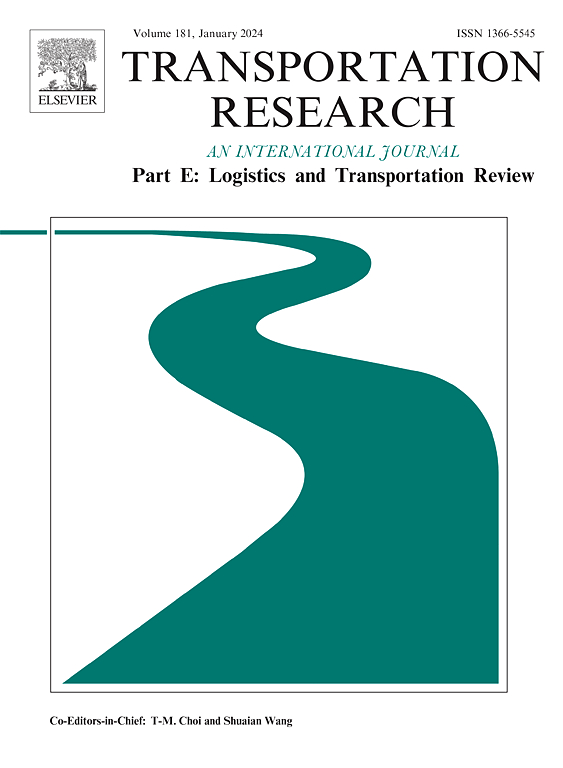一种面向最后一英里物流的智能多主体系统
IF 8.3
1区 工程技术
Q1 ECONOMICS
Transportation Research Part E-Logistics and Transportation Review
Pub Date : 2025-05-21
DOI:10.1016/j.tre.2025.104191
引用次数: 0
摘要
最后一英里物流(LML)的运营效率经常受到波动的电子商务需求、不可预见的中断以及目标不断变化的不同利益相关者的阻碍。本文旨在通过开发一个专注于利益相关者互动的智能多代理系统(iMAS)来评估物理互联网中心(pi -hub)在解决LML挑战方面的有效性。在iMAS中,运营商、托运人和物理互联网管理人员(pi - manager)被视为学习代理。在这个复杂的场景中,分销网络(DN)结构是动态的,当运营商和托运人使用pi集线器时,从单层系统过渡到双层网络。贝叶斯q -学习通过平衡探索和利用来优化行动选择,而公平的奖励分配使智能体激励一致,在动态的多智能体环境中提高合作、稳定性和性能。进行了涉及不同学习代理组合的模拟。两种运输车辆类型也被纳入到协同车辆路径问题中,形成iMAS环境。将模拟结果与智能体不参与学习的基本情况进行比较。研究结果表明,当pi管理人员参与学习时,pi枢纽的使用百分比增加,车辆行驶总公里数(VKT)减少,突出了pi枢纽在缓解大都市地区货运车辆流动性不利影响方面的有效性。初始PI-hub收费政策对DN效率的影响,包括PI-hub使用率、VKT、运营商和托运人成本以及PI-Manager利润,通过广泛的敏感性分析进行评估。iMAS作为一个决策支持系统,使决策者能够评估各种政策和行动,帮助确定LML框架内的最佳决策。本文章由计算机程序翻译,如有差异,请以英文原文为准。
An intelligent multi-agent system for last-mile logistics
Operational efficiency in last-mile logistics (LML) is often hindered by fluctuating e-commerce demand, unforeseen disruptions, and diverse stakeholders with evolving objectives. This paper aims to evaluate the effectiveness of Physical Internet hubs (PI-hubs) in addressing LML challenges by developing an intelligent multi-agent system (iMAS) that focuses on stakeholders’ interactions. In the iMAS, carriers, shippers, and Physical Internet managers (PI-Managers) are considered learning agents. In this complex scenario, the distribution network (DN) structure is dynamic, transitioning from a single-tier system to a two-tier network when carriers and shippers utilize PI-hubs. Bayesian Q-learning optimizes action selection by balancing exploration and exploitation, while fair reward distribution aligns agent incentives, improving cooperation, stability, and performance in dynamic, multi-agent environments. Simulations involving varying combinations of learning agents are performed. Two delivery vehicle types are also included in the collaborative vehicle routing problem, forming the iMAS environment. The simulation results are compared with the base case where agents do not engage in learning. Findings suggest that when PI-managers engage in learning, there is an increase in the percentage of PI-hub usage and a decrease in total vehicle kilometers traveled (VKT), highlighting the effectiveness of PI-hubs in alleviating the adverse impacts of freight vehicle mobility within metropolitan areas. The impact of the initial PI-hub fee policy on DN efficiency, including PI-hub usage, VKT, carriers’ and shippers’ costs, and PI-Manager profit, is assessed through extensive sensitivity analysis. The iMAS acts as a decision support system enabling policymakers to evaluate various policies and actions, aiding the identification of optimal decisions within the LML framework.
求助全文
通过发布文献求助,成功后即可免费获取论文全文。
去求助
来源期刊
CiteScore
16.20
自引率
16.00%
发文量
285
审稿时长
62 days
期刊介绍:
Transportation Research Part E: Logistics and Transportation Review is a reputable journal that publishes high-quality articles covering a wide range of topics in the field of logistics and transportation research. The journal welcomes submissions on various subjects, including transport economics, transport infrastructure and investment appraisal, evaluation of public policies related to transportation, empirical and analytical studies of logistics management practices and performance, logistics and operations models, and logistics and supply chain management.
Part E aims to provide informative and well-researched articles that contribute to the understanding and advancement of the field. The content of the journal is complementary to other prestigious journals in transportation research, such as Transportation Research Part A: Policy and Practice, Part B: Methodological, Part C: Emerging Technologies, Part D: Transport and Environment, and Part F: Traffic Psychology and Behaviour. Together, these journals form a comprehensive and cohesive reference for current research in transportation science.

 求助内容:
求助内容: 应助结果提醒方式:
应助结果提醒方式:


